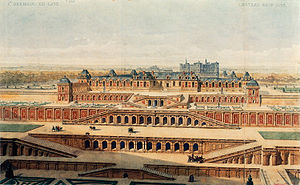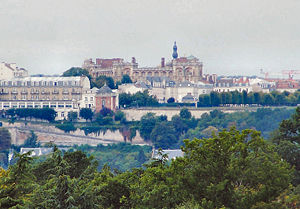
Chateau-Neuf de Saint-Germain-en-Laye
Encyclopedia

Château
A château is a manor house or residence of the lord of the manor or a country house of nobility or gentry, with or without fortifications, originally—and still most frequently—in French-speaking regions...
(country house or castle
Castle
A castle is a type of fortified structure built in Europe and the Middle East during the Middle Ages by European nobility. Scholars debate the scope of the word castle, but usually consider it to be the private fortified residence of a lord or noble...
), now mostly demolished, which served as the royal residence from the second half of the 16th century until 1680.
Construction
The central building, on the edge of the terrace, was ordered in 1556 by Henry II of FranceHenry II of France
Henry II was King of France from 31 March 1547 until his death in 1559.-Early years:Henry was born in the royal Château de Saint-Germain-en-Laye, near Paris, the son of Francis I and Claude, Duchess of Brittany .His father was captured at the Battle of Pavia in 1525 by his sworn enemy,...
and Catherine de' Medici
Catherine de' Medici
Catherine de' Medici was an Italian noblewoman who was Queen consort of France from 1547 until 1559, as the wife of King Henry II of France....
and was built by Philibert de l'Orme
Philibert de l'Orme
Philibert DeLorme was a French architect, one of the great masters of the French Renaissance.He was born at Lyon, the son of Jean Delorme, a master mason. At an early age Philibert was sent to Italy to study and was employed there by Pope Paul III...
. Called in its day la maison du théâtre (the theater house), a succession of terraces and stairs gave access to the baignerie (from French
French language
French is a Romance language spoken as a first language in France, the Romandy region in Switzerland, Wallonia and Brussels in Belgium, Monaco, the regions of Quebec and Acadia in Canada, and by various communities elsewhere. Second-language speakers of French are distributed throughout many parts...
baigner, "to bathe") on the Seine
Seine
The Seine is a -long river and an important commercial waterway within the Paris Basin in the north of France. It rises at Saint-Seine near Dijon in northeastern France in the Langres plateau, flowing through Paris and into the English Channel at Le Havre . It is navigable by ocean-going vessels...
.
From the beginning of his reign in 1593, King Henry IV
Henry IV of France
Henry IV , Henri-Quatre, was King of France from 1589 to 1610 and King of Navarre from 1572 to 1610. He was the first monarch of the Bourbon branch of the Capetian dynasty in France....
would come to Saint-Germain because he took pleasure in the view the château and its terraces offered of the valley of the Seine, a view like that of his birthplace, the Château de Pau
Château de Pau
The Château de Pau is a castle in the centre of Pau, the capital of Pyrénées-Atlantiques and Béarn. King Henry IV of France and Navarre was born here on December 13, 1553....
. He ordered from Baptiste Androuet du Cerceau an expansion of the terraces by the Seine. Work began in 1594.
Quickly finished by executive architect Jean de Fourcy, with Guillaume Marchant conducting the masonry work, the job involved the installation of grotto
Grotto
A grotto is any type of natural or artificial cave that is associated with modern, historic or prehistoric use by humans. When it is not an artificial garden feature, a grotto is often a small cave near water and often flooded or liable to flood at high tide...
es, with automated fountains made by Italians, the Francini brothers, Thomas and Alexandre. The French garden, spread out by the Seine on five terraces, was designed by landscape design
Landscape design
Landscape design is an independent profession and a design and art tradition, practised by landscape designers, combining nature and culture. In contemporary practice landscape design bridges between landscape architecture and garden design.-Design scope:...
er Étienne Dupérac
Étienne Dupérac
Étienne Dupérac was a French painter, draughtsman and engraver, and a topographer and antiquary, who arrived in Rome in 1559...
and by gardener Claude Mollet
Claude Mollet
Claude Mollet , premier jardinier du Roy— first gardener to three French kings, Henri IV, Louis XIII and the young Louis XIV—was a member of the Mollet dynasty of French garden designers in the seventeenth century...
.
History
At the outset, the château was the dwelling of those who had it built: Henry II, who died in 1559, from a lance wound received in a tournament in Paris, three years after the château was begun; and, above all, Catherine de' MediciCatherine de' Medici
Catherine de' Medici was an Italian noblewoman who was Queen consort of France from 1547 until 1559, as the wife of King Henry II of France....
.
Henry II would expand Château-Neuf considerably and sojourn there regularly, while his numerous children, legitimate and bastard, lived at Château-Vieux.
Catherine stopped going to the château toward the end of her life in 1589, after her astrologer
Astrology
Astrology consists of a number of belief systems which hold that there is a relationship between astronomical phenomena and events in the human world...
, Côme Ruggieri, predicted that she would meet her death in Saint-Germain.
In 1562, two years after the death of King Francis II of France
Francis II of France
Francis II was aged 15 when he succeeded to the throne of France after the accidental death of his father, King Henry II, in 1559. He reigned for 18 months before he died in December 1560...
on December 5, 1560, the Queen of Navarre
Jeanne III of Navarre
Jeanne d'Albret , also known as Jeanne III or Joan III, was the queen regnant of Navarre from 1555 to 1572. She married Antoine de Bourbon, Duke of Vendôme, and was the mother of Henry of Bourbon, who became King of Navarre and of France as Henry IV, the first Bourbon king...
arrived in Saint-Germain escorted by a grand cortège at the head of which rode her spirited second husband, the Duke of Vendôme. Several days of festivals ensued with diverse games and even a bullfight. Among the guests was their son, the 9 year old Henri de Béarn, the future Henry IV
Henry IV of France
Henry IV , Henri-Quatre, was King of France from 1589 to 1610 and King of Navarre from 1572 to 1610. He was the first monarch of the Bourbon branch of the Capetian dynasty in France....
, and Henry II's third son, the 11 year old Duke of Orléans who would become the future Henry III
Henry III of France
Henry III was King of France from 1574 to 1589. As Henry of Valois, he was the first elected monarch of the Polish-Lithuanian Commonwealth with the dual titles of King of Poland and Grand Duke of Lithuania from 1573 to 1575.-Childhood:Henry was born at the Royal Château de Fontainebleau,...
.
It was in this château that "Louis-Dieudonné" (Louis the God-given), the future King Louis XIV, was born on September 5, 1638. His father, Louis XIII, died there on May 14, 1643.
Château-Neuf was the refuge of Charles II of England
Charles II of England
Charles II was monarch of the three kingdoms of England, Scotland, and Ireland.Charles II's father, King Charles I, was executed at Whitehall on 30 January 1649, at the climax of the English Civil War...
in 1650, after the execution of his father.
During the Fronde
Fronde
The Fronde was a civil war in France, occurring in the midst of the Franco-Spanish War, which had begun in 1635. The word fronde means sling, which Parisian mobs used to smash the windows of supporters of Cardinal Mazarin....
, the French civil war in the mid-17th century, the "Grande Mademoiselle", Anne Marie Louise, Duchess of Montpensier, came to Saint-Germain seeking asylum and installed herself at Château-Neuf where "she lay in a wonderfully beautiful chamber in a ruined tower, well-gilded and large but with no glass in the windows and a meager fire."
In 1668, a grand ceremony was organized that set off from the Château-Neuf for the baptism of the Grand Dauphin at the Sainte Chapelle of the Old Château.
In 1682, the French Court left Saint-Germain for the Palace of Versailles
Palace of Versailles
The Palace of Versailles , or simply Versailles, is a royal château in Versailles in the Île-de-France region of France. In French it is the Château de Versailles....
.

James II of England
James II & VII was King of England and King of Ireland as James II and King of Scotland as James VII, from 6 February 1685. He was the last Catholic monarch to reign over the Kingdoms of England, Scotland, and Ireland...
to base himself at Saint-Germain. There he stayed with his court in Château-Neuf, and then in the two châteaux, until his death.
In the 1770s, the dilapidated château was given by Louis XVI to his younger brother the Comte d'Artois
Charles X of France
Charles X was known for most of his life as the Comte d'Artois before he reigned as King of France and of Navarre from 16 September 1824 until 2 August 1830. A younger brother to Kings Louis XVI and Louis XVIII, he supported the latter in exile and eventually succeeded him...
with the sum of 600,000 livre
French livre
The livre was the currency of France until 1795. Several different livres existed, some concurrently. The livre was the name of both units of account and coins.-Etymology:...
s for work to be done on it. Demolition and reconstruction projects were carried out by the architects Joseph Bélanger et François Chalgrin.
When the Revolution
French Revolution
The French Revolution , sometimes distinguished as the 'Great French Revolution' , was a period of radical social and political upheaval in France and Europe. The absolute monarchy that had ruled France for centuries collapsed in three years...
came, the Château was declared bien national and sold to its former manager, who demolished it, parceled out the land, and sold the materials. Nothing remains today but the Pavilion of Henry II, the Pavillon du jardiner, and a few vestiges of the cellars to be found in the neighborhood – 3 rue des Arcades, for example.
External links
- Château Neuf de Saint Germain en Laye History, photographs, and plan.

